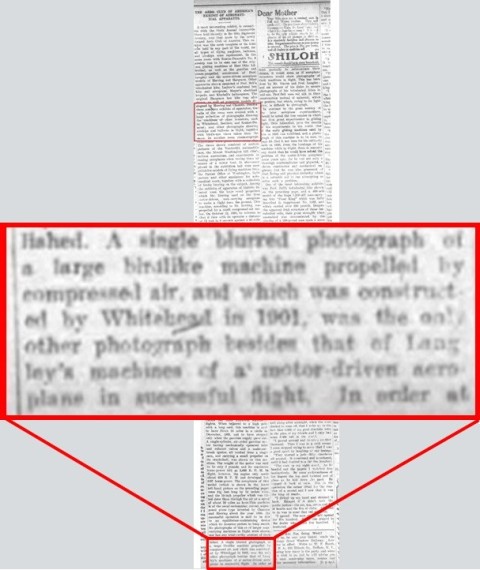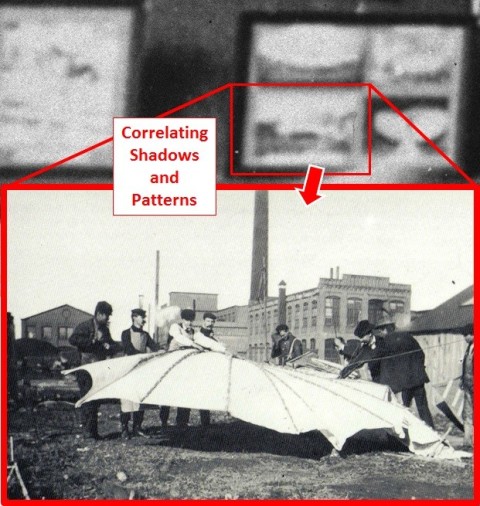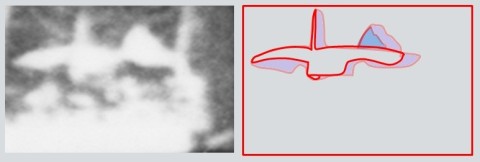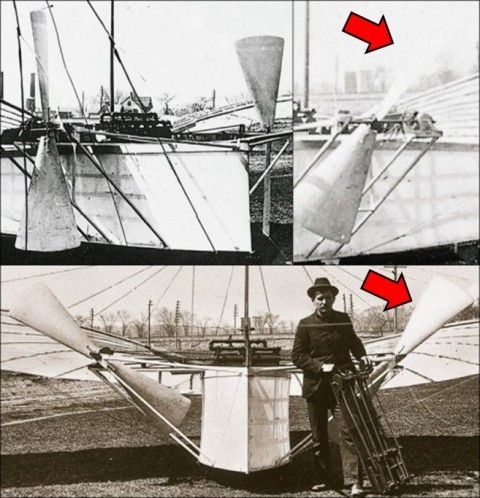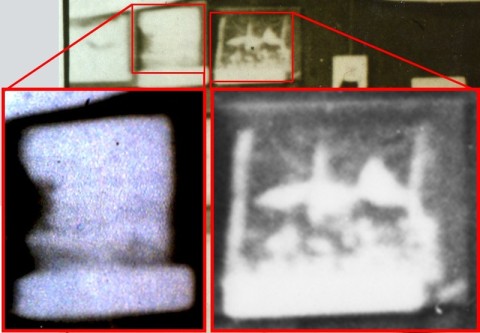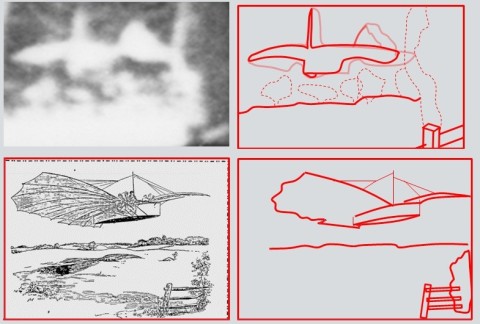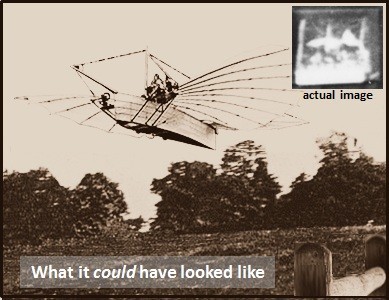Executive Summary:
a). Two 1906 press reports describe seeing a blurred photo of Whitehead's 1901 powered monoplane in flight at a Jan. 1906 exhibition. (One appeared in Scientific American, filed by its Aeronautical Editor.)
b). A panorama photo of that exhibition exists. The veracity of the eyewitness report can therefore be checked. To do so, the
panorama photo needs to be enlarged several thousand percent using modern computer technologies.
Here, briefly, is what the analysis below shows:
- there were 10 images on display in the Whitehead section;
- of those, 8 do not show an aircraft in flight;
- one could, but its resolution is too poor to verify details;
- in one photo, 5 of 6 details in the report are discernable.
(The 6th detail is not discernable at such high maginifcation. However, nothing in the photo rules it out either. Furthermore, 4
circumstantial aspects of the photo appear to support its presence.)
c). A different report by a different newspaper about another exhibit 15 months
earlier describes two photos on display there. Their content matches the details contained in the two articles above as
well as those in the photo analyzed.
d). In a fourth newspaper - the one whose Chief Editor published the original, eyewitness report of Whitehead's 1901 flight - all the details visible in the photo and all the details decribed in the other three articles, are described.
e). That fourth article is accompanied by a lithograph which was half-toned based on a photo of the flight (since lost when the newspaper ceased publication). All the details shown in that lithograph match the photo - except for standard retouching of a kind customary at the time. Furthermore, the details shown in the lithograph match the decriptions published in the other three articles.
Detailed Analysis, Whitehead Flight-Photo & Related Sources
Four contemporary news articles describe the contents of a photo of a powered Whitehead aeroplane in flight. Two of them refer specifically to the first exhibition of the Aero Club of America, January 13-20, 1906, in New York. There, they report seeing a photo of a 1901 Whitehead aeroplane in motor-driven flight on display:
Source 1: Magazine, Scientific American, Jan. 27, 1906, p. 94
Source 2: Newspaper, Silver Springs Signal, Mar. 8, 1906, p.3
Although Scientific American is generally considered a relaible source, critics have questioned the credibility of the Scientific American report. They speculate, Stanley Yale Beach may have been its author. Beach had been a customer/partner of Whitehead, was therefore biased, they say, and may have reported untruthfully... Was the report credible?
Investigation of Reports' Credibility:
When examining the credibility of the articles, two questions arise:
1. Is there proof that a Whitehead photo was on display at the exhibition?*
2. If yes, does the content of any such photo match what the article says?
[*In a conversation between the author of this website and Smithsonian Chief Historian, Tom Crouch, on March 8, 2012, Tom questioned whether any Whitehead photos had been on display at the exhibition.]
Investigation, Question 1:
Several panorama photos of the exhibition exist. One is of particular interest because it is suspected of showing a Whitehead Section with photos on display:
Panorama Photo with Suspected Whitehead Section Marked:
Enlargement of Suspected Whitehead Section:
Comparison of Bottom Right Photo with Known Photo:
Comparison of Top Left Photo in Frame with Known Photo:
Comparison, Bottom Left Photo in Frame with Known Photo:
Comparison, Top Right Photo Beyond Frame w. Known Photo:
The analysis of this particular photo was interesting because, since 1981, Whitehead researchers had suspected it showed Whitehead's motor-driven machine in flight. Forensic photo analysis technology proved, however, that it didn't.
Instead, it showed a known image of a 1903 Whitehead glider. The image was portrayed in light/dark, high/low-contrast, black&white/sepiatone and many other technical variations to make this determination:
Comparison, Top Left Image Beyond Frame w. Known Image:
Answer to Question 1:
Evidence substantiates Whitehead photos were on display at the first exhibition of the Aero Club of America in January 1906 in New York. The answer to question one is therefore "yes".
Consequently, the articles did not lie about the existence of Whitehead photos and are credible in this regard.
Investigation, Question 2:
Does any photo match the content described in the articles?
Content Analysis, Image 2nd From Top Left:
In forensic photo analysis, a fair starting assumption is that the object being photographed will be near the center of the image. When the context of how a photo was displayed is also known, then it's also fair to assume that any sky will be in the upper part and any ground or shadows will be in the lower part of the image (and that any horizon will be located between them). At an aircraft exhibition, it's also fair to assume that any picture on display will show an aircraft or something related. And in the Whitehead section, that any object would likely be something made by Whitehead.
Due to its poor quality, these assumptions don't help much when analyzing the image below:
Although nothing conclusive can be ascertained from the above image, by varying contrast, brightness, clarity and other factors, faint outlines of an object near the center of the image are vaguely discernable (along with what appears to be a shadow of roughly similar size somewhat below it and to its right):
(Purely hypothetically, if the faintly-discernable object were to be an airplane with a wingspan the size of Whitehead's 1901 aircraft (36ft.) then the distance from its level to the level of the shadow would be approximately two-thirds of that, i.e. 20 ft.. But again, the resolution of this image is simply too poor to reach any sound conclusion about its content - at least when applying current forensic technologies to the currently available image.)
Content Analysis, Image in Frame at Top Right:
Of the four images in the frame, three are identifiable as known 1901 images of Whitehead's "No. 21" aircraft on the ground. The patterns and shadows of the one at top right are also consistent with that particular aircraft. However, although several known images are similar, none match its patterns and shading.
What an analysis of the photo, however, does determine is that the object is on the ground. This is because of its close proximity to its own shadow. (This image therefore cannot show an airborne object as described in the articles.)
(Of known images similar to this one, the one shown directly above these lines at the right appears to be the closest match. It's a lithograph which appeared in the June 16, 1901 issue of The New York Herald. It was presumedly drawn based on the photograph shown on display here, the whereabouts of which are now unknown.)
Content Analysis, Lone Image Right of Center:
The above image shows an object of uniform material and/or shading on a uniformly-shaded surface against a uniformly-shaded background. In connection with its context and the fact Whitehead was an engine-builder, it appears likely the photo may show an engine or transmission block on a flat surface such as a floor or table with a wall in the background.
Content Analysis, Image at Bottom Left:
Here again, the previously-mentioned assumptions of photo analysis apply, i.e. if "which way is up" is known, any sky will be in the upper, any ground in the lower and any horizon in the mid-part between them. Also, that the object being photographed will be near the middle of the photo. Furthermore, the context (an aircraft exhibition) suggests, the content is likely to be an aircraft or something related.
In this image, digital enhancement reveals three lines extending from the object downward. The lines emanate from one, single point in the lower, left part of the image and diverge, ending at the left extremity, mid-point and right extremity of the object, respectively. The lines, their angle and the shape of the object suggest it may be a kite. [Whitehead's brother, John, testified that the two of them built a kite to test the wing-warping system they'd developed.]
(One of Whitehead's jobs when working for E.I. Horsman in 1897 in New York was to perform kite displays. Whitehead is known to have built and experimented with many kites. A picture of one of his kites was published in the December, 1902 edition of Aeronautical World (below). Unlike normal kites, it had a rudder.)
Content Analysis, Image at Top Center:
The Above Image Appears to Show:
Light, over-exposed edge on the left side typical of photo technology used at the time (see Wright image, below):
1. horizon falling off to the left;
2. brightly-lit ground/objects & a dark sky (consistent with dawn, sunset or an approaching storm-front);
3. clumps on the horizon, narrow at the bottom and spreading out into irregular shapes on top (consistent with trees);
4. interruption of the horizon on the right edge of the image by an object which is narrow in its lower reaches and spreads out in its upper reaches, having both an irregular shape and irregular shadows (consistent with a tree) and being uniformly light along its left side only (consistent with sunlight shining upon it);
5. object with a vertical component at its left side which has a regular shade pattern - lighter at top, somewhat darker at front and dark at right - (consistent with a fencepost), and
6. a more horizontal component which also has a regular shade pattern - light on top and somewhat darker at its right - (consistent with the crossbeam of a fence);
7. light shading on objects' left sides, dark shading on objects' right sides and only a medium-tone, gray shading on what appears to be the only visible top side of an object (consistent with either dawn or sunset, but NOT consistent with midday light conditions);
8. an object at the center of the image with a narrow protrusion upward from its mid-point (consistent with a mast) and
9. a central section extending downward from the middle of the object which abruptly transitions into somewhat thinner protrusions to the left and right of it (consistent with a fuselage and wings).
10. hypothetically assuming the object depicted were to be an aircraft (since its being shown at an aircraft exhibition), its shape would be consistent with a monoplane (but not with a bi-plane or a multi-plane);
11. Assuming the object's vertical protrusion is a thin mast, the fact it appears wider in the image could be attributable to blurring caused by movement. If the same degree and direction of blurring is applied to the whole object, a more deliniated shape is discernable (consistent with a high-wing monoplane moving from right to left at a slightly upward trajectory).
12. the distance of the object from the lower edge of the image is approximately two-thirds of the object's width.
13. assuming, hypothetically, it were to be a Whitehead aircraft (since it's in the Whitehead Section), its dimensions - in regard to how its components are placed relative to each other - would conform to the known configuration of Whitehead's aircraft No. 21 (other photos of which have been positively identified on display next to it). Whitehead's No. 21 was known to have a mast, fuselage and wingspan in proportions closely resembling those of the object shown in the image being analyzed:
14. At first impression, the protrusion from the upper right of the object appears to be inconsistent with a Whitehead monoplane...
Upon examination of the sources, however, several plausible explanations emerge:
14a. one contemporary photo of Whitehead's No. 21 shows the outermost element of its left wing (between the eight & ninth ribs) de-rigged, i.e. not held in place by guy-wires. The photo was taken following a crash in autumn, 1901. Presumedly the derigging of the outer element was a result of the crash (or preceeding flight) and not an intended design feature. Wingtips are susceptible to strong forces imposed by what's called "induced drag" (an upwardly-swirling type of eddy, not known at the time.) Such a wing element deflected upward by induced drag would best explain the protrusion visible in the image;
What makes matters worse was an apparent design-fault. The rigging wires didn't brace the wingtip. They only braced the first two-thirds of the wing. The only thing holding the wingtip in position was the fibre of the bamboo itself (at its thinnest point). Aerodynamic pressure would certainly create a tendency for such a wingtip to buckle upward. This would appear to be a likely explaination for what's visible in the photo.
In the scene below, the detached 9th wing section is being pulled upward in a manner similar to how it apparently also appears in the flight photo, showing its triangular shape:
14b.Whitehead's No. 21 aircraft employed "Maxim Type-J" propellers which rotated slowly (600 RPM), were 6 ft. long and had a relatively wide blade area (4 sq. ft.). They were polished and variously described as having been covered with a thin layer of aluminium sheeting. Contemporary photos show them reflecting sunlight. Under conditions such as those suggested in the image (i.e., low sun position), the possibility a blade may have been reflecting sunlight cannot be discounted; (even when using modern forensic technology, a better-quality image would be needed to discern such detail):
14c. When viewed from the side, the near wing of Whitehead's No. 21 aircraft arches up. This can be seen in both contemporary photos of the original aircraft on the ground and in modern photos of replicas in flight. When employing an early camera with a wide aperture and a slow shutter-speed, a slowly-rotating, large propeller-blade might wholly or partially obscure a wing located behind it;
14d. Guy-wires coming from the tips of each wing-rib converge to a single point in the area in question. From there, only one wire extends to the tip of the mast. (Reflection of morning-dew or oil on the wires, or from a sheen finish on the wires themselves, might possibly contribute to the lightness of that area.)
Access to and analysis of the original panorama photo could likely resolve this point.
The original photo (along with many others taken at the exhibition) is part of the Hammer Collection:
The William J. Hammer Collection is located at the Smithsonian Institute: http://airandspace.si.edu/research/arch/findaids/pdf/william_j_hammer_collection_finding_aid.pdf
Researchers are denied access:
15. the shape of the trees shown in the background of the photo is consistent with that of trees shown in other, known photos showing Whitehead aircraft.
Elimination of 8 of the 10 Whitehead Photos
Of the ten photos in the Whitehead Section, eight can be eliminated from consideration because they do not show the content which the two articles decribe, that being:
"A single blurred photograph of a large, birdlike machine propelled by compressed air, and which was constructed by Whitehead in 1901, was the only other photograph besides Langley's machines, of a motor driven aeroplane in successful flight".
The image below indicates which photos appear not to show a motor-driven aircraft in flight:
Two Remaining Photos:
Only the two photos shown below remain under consideration as possibly showing a "large, birdlike, motor-driven Whitehead machine in flight":
Elimination of one further photo:
Unfortunately, even using current forensic technology, the quality of the photo at left is too poor to enable reasonable conclusions to be reached, leaving only the one at right.
Criteria:
To conform to the articles' content, it must contain the following features:
1. blurred photograph
2. large birdlike machine
3. in flight
4. motor-driven
5. by Whitehead
6. in 1901.
Criterion 1: "blurred photograph"
When compared with other, known photos, the photo in question is indeed blurred. (Interestingly, this only applies to the main object. The objects in the foreground - presumedly fencepost and lone tree - appear to be well-focused. The blurring of the main object could result from either poor lensecraft or fast movement.)
With the cameras of the time, blurring was not unusual. Two photos of the Wrights' glider, taken using glass-plate technology, are blurred to varying degrees: [Note: the images below are not magnified several thousand percent.]
Criterion 2: "large, birdlike machine"
Biplanes, triplane and tandem-wing aeroplanes (of the type displayed by other participants at the exhibition) are not "birdlike" because they have more wings than birds do. Only a monoplane is "birdlike". Indeed, contemporary literature used the term "birdlike" to make this differentiation. (In this regard, the only other photos to show a "birdlike" aircraft displayed at the exhibition were several showing early Lilienthal gliders.)
The structural disadvantage of a monoplane is that it needs to be much larger than biplanes, triplanes or tandem-wing aircraft to achieve the same wing-area (assuming all aircraft have only one occupant).
The aircraft depicted in the photo would therefore appear to fulfil both aspects of this criterium, i.e. "birdlike" and "large", when compared to other exhibits.
Criterion 3: "in flight"
The object shown in the photo, presumedly an aircraft, appears to be well above the ground. No supports are visible.
Criterion 4: "motor-driven"
This detail cannot be conclusively ascertained due to the degree of magnifaction of the photo. However, it also cannot be ruled out.
- There are faintly discernable elements consistent with propellers;
Circumstantially, there are
- no tow-ropes visible,
- no launch-place on higher ground,
- the photo is located adjacent to photos of Whitehead's motor-driven "No. 21",
- Whitehead's motor-driven "No. 21" was the only one of his aircraft to have a mast and fuselage in the places and proportions shown in the photo.
Criterion 5: by "Whitehead"
The photo is clearly in the Whitehead Section.
Criterion 6: "1901 aircraft"
After January 1902, Whitehead did not build or operate a monoplane with a fuselage.
A German TV report shows better quality versions of the photo.
Deliberating a Judgement:
Answer to Question 2:
Evidence supports the existence of at least one photo containing a "large birdlike machine" "in flight" on display in the "Whitehead" Section of the exhibit, as described in the two press reports. The aircraft appears to be at a height roughly two-thirds of its wingspan and the blurring appears to indicate it may be moving at a slightly upward trajectory, thereby also lending credence to the articles' statement that it shows a "successful" flight. Neither ground-supports, nor tow-ropes, nor a higher launching-point are visible. Shaping in the area adjacent to the hull may indicate optical disturbances caused by a propeller. Images of the only known, powered, Whitehead monoplane with a fuselage are located directly next to the photo and its shape is consistent with the aircraft depicted. It therefore cannot be ruled out that the photo shows a "motor-driven" flight. Indeed, a preponderance of the evidence would appear to support that it does.
The answer to question two therefore also appears to be "yes" in regard to 5 out of 6 features shown in the photo and described in the article. And although sufficient detail is lacking to definitively identify the 6th feature, it is vaguely discernable and circumstantially indicated meaning, it cannot be ruled out that the answer here is also "yes".
Consequently, the articles appear not to have lied about the existence of a Whitehead photo showing a large birdlike machine in successful flight which they state was motor-driven. They therefore appear to be credible in this regard too.
When assessing the three sources referenced thus far (articles/photo), much depends on how each individual reader subjectively weighs credibility:
- on the one hand, the credibility of the articles,
- on the other hand, the credibility of modern photo analysis.
Persons who afford the articles a high degree of credibility, might accept the eye-witness report of Scientific American's Aeronautical Editor and trained journalist about what the photo shows and deem the photo-analysis to confirm the reports' veracity.
Persons who afford the articles a low degree of credibility would possibly reserve judgement on what the photo analysis shows (while not discounting the possibility the reports were correct).
The same deliberations apply vice-versa to the forensic photo analysis. However, there's more...
Further Corroboration:
So far, this analysis has referenced only three sources:
Source 1: Scientific American, Jan. 27, 1906, p.94
Source 2: Silver Spring Signals, March 8, 1906, p.3
Source 3: Panorama photo of Jan. 13-20, 1906 exhibition
However, there are two other, directly relevant sources:
Source 4: Article describing photo, published Oct. 1, 1904
Source 5: a). Lithograph based on photo published August 18, 1901
b). Article describing Whitehead's first flight August 18,
1901
Source 4: Article in Bridgeport Daily Standard, Oct. 1, 1904
The Bridgeport Daily Standard reported in its Oct. 1, 1904 edition, page 5, that two photos of Whitehead in flight, one of them showing him at a height of about twenty feet, were on display in the shop window of the hardware store, "Lyon & Grumman's".
[Again, critics allege, this was another case of "opportunistic journalism". They insist it must be disregarded, just like the other three reports must also be disregarded. Once more, readers are asked to weigh credibility, this time that of Whitehead's critics (foremost among them, Wilbur Wright and the curators of his airplane) on the one hand, and that of the four publications, on the other hand.]
Source 5). a). Lithograph published August 18, 1901
A photo taken of Whitehead's first flight on August 14, 1901 by the Chief Editor of the Bridgeport Sunday Herald, Richard Howell, was half-toned to create the lithograph which appeared in that newspaper's August 18, 1901 edition. (The Bridgeport Sunday Herald is a different newspaper to the Daily Standard). The original photo was later lost when the newspaper ceased publication. However, the lithograph survived:
[Critics allege, the report was a case of "opportunistic journalism" designed to sell papers and promote a local resident. They insist, it must be ignored.]
Analysis of the Lithograph:
The lithograph embodies the following features:
- horizon at mid-height of the image;
- horizon falling off slightly to the left;
- tree along right-hand side of the image;
- fencepost with crossbeams extending into tree at lower right;
- aircraft at center
at a height of about 2/3 its span;
- slightly upward trajectory of the aircraft;
- direction of flight towards viewer at approx. 45° angle off center;
- mast rising from center of object;
- wide spread and upward arch of near wing;
- aircraft traveling from left to right;
- trees on horizon below aircraft's underside;
- tree at right extends only up to horizon.
When the features of the 1901 lithograph are compared with the photo displayed at the Jan. 1906 exhibition, there are a large number of similarities which would be almost impossible to duplicate in exactly the same manner in another photo. And yet, there are two differences:
- the aircraft's trajectory is mirrored (i.e., facing "the other way"), &
- none of the trees are as high as the aircraft.
Here's where knowledge of the forgotten art of lithography comes in...
Why Half-Toning (Lithographs) were used
1). Cost Reduction:
Printing photographs in newspapers used to be extremely expensive. That's why lithography or "half-toning" was invented. By reducing an image to its outlines, massive cost savings were achieved. Without the use of half-toing, many small newspapers wouldn't have been able to afford to ilustrating their articles (see how high-resolution Whitehead photo below was simplified for printing):
2). Touching Up:
Just like modern photographers "touch up" their pictures, lithographers were also expected to optimize their images.
When - five years after Whitehead's claimed flight, the Romanian inventor, Dr. Traian Vuia, got his aircraft to briefly leave the ground (on March 18, 1906), it was front-page news. A fine, focused image of the scene was available. And yet, a well-financed publication like the New York Herald chose to have a lithograph made instead. The reasons were: "time & money". Another reason was being able to print a "better" image.
If one looks closely, one sees that the lithographer "cleaned up" the image. A stray bicycle was removed (at lower left) and a rip in the wing's fabric (top right) was "repaired.
3). Clarity
When touching up an image, a "cluttered" background is sometimes "cleaned up" to improve the contrast so that the main object can be seen clearly. In the Whitehead photo below, the lithographer removed trees and grassland, leaving only the clear contours of the aircraft he was trying to illustrate:
And here, the lithographer even "got rid of" Whitehead and his daughter, Rose, to give a clearer view of the aircraft:
4) Composition:
The principles of "image composition" have remained the same for centuries. Persons or objects are always placed facing (or traveling toward) the center of a page (not looking or heading off its side)
That's what the lithographer appears to have done here. Rather than have the aircraft flying off the page to the left, the flight-trajectory appears to have been mirrored so that it is flying toward the center of the page. And the trees also appear to have been "lowered" to both "clean up" the background and to make sure the aircraft was not on a collison course with the large tree, originally on the right. These types of alterations were absolutely normal back then:
How Lithographers Altered Backgrounds & Flight Trajectories:
Compared with the massive, worldwide news coverage of Whitehead's first powered flight in 1901, relatively few newspapers reported the Wright brother's first powered flight in 1903. As was standard practice, the few that did accompanied their articles with lithographs based on original photographs. And, as was standard practice - without exception - the background and flight trajectory were changed (including a mirrored trajectory):
Changed Background/Trajectory of Wright Flyer, Jan. 2, 1904
In the image below, the lithographer replaced the sand dunes of Kitty Hawk with a grassy hillside, removed the launch helpers and slightly altered the direction of the flight:
Mirrored Trajectory of Wright Flyer, Dec. 20, 1903
The image below accompanied an article printed just three days after the Wrights' flight. The lithographer supplanted the background's sand dunes with a riverside community, seated the pilot upright, added a maritime-type propeller along with a fanlike steering surface and reversed the flight direction:
Lithographer's Optimization of Whitehead Flight Photo:
Compared with standard lithography of the time, the "touching-up" of what appears to be the Whitehead image was relatively mild:
How the Original Photo May Have Looked:
Source 5). b). Text of Aug. 18, 1901 Bridgeport Herald Article
The eyewitness report by the Chief Editor of the Bridgeport Sunday Herald, Richard Howell, contains the following details, all of which are consistent with the photo on display at the 1906 exhibition:
Conclusion:
Detailed descriptions of the contents of a photo of a Whitehead aircraft in flight were published in four articles in four different publications in the years 1901 to 1906. Two of the articles pinpoint exactly where to find the photograph.
Although only the enlargement of a tiny, background portion of a panorama photo shows that point, an image consistent with the contents described in the articles can be found there.
The argument of critics who insist all four reports must be ignored because - in each case - the journalist was biased and acting out of self-interest, weakens as the number of publications increases. At the time, Whitehead was not known to be spending any money on advertising which would have enriched any of the publications. Indeed, the historical record shows he was close to broke. It's unclear why journalists would have had cause to falsify their reports to Whitehead's benefit and why credence should be given to such an argument. Indeed, almost 100 contemporary articles by publications around the world are known to have reported Whitehead's 1901/1902 powered flights. It would have been a massive conspiracy of proportions unseen in the annals of history if all those publications had secretly banded together to falsify the record.



